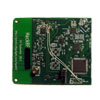 Generations of hobbyists hardware hackers have spent countless hours messing with piles of radio gear, happily tinkering away in garages and basements looking for new ways to connect to people around the world. Now, a researcher has put together a new radio called HackRF that is a kind of all-in-one hacker’s dream with functionality to intercept and reverse-engineer traffic from a wide range of frequencies and sources.
Generations of hobbyists hardware hackers have spent countless hours messing with piles of radio gear, happily tinkering away in garages and basements looking for new ways to connect to people around the world. Now, a researcher has put together a new radio called HackRF that is a kind of all-in-one hacker’s dream with functionality to intercept and reverse-engineer traffic from a wide range of frequencies and sources.
HackRF is the work of Michael Ossmann of Great Scott Gadgets, and the idea behind the project was to build a multipurpose transceiver that a user could attach to his computer and use as a “software-defined radio”. Ossmann has released the hardware specifications and the software for the radio, called HackRF Jawbreaker, on Github, and the device has the ability to transmit and receive over a wide range of frequencies, covering a huge number of commercial devices.
“Jawbreaker integrates three separate designs into a single circuit board, making it smaller and easier to handle. Since my previous post, I tested multiple wideband front-end designs, eventually settling on one called Licorice. Jawbreaker is a combination of Licorice, Lemondrop, and Jellybean into a single USB-powered software radio transceiver peripheral designed to operate from 30 MHz to 6 GHz,” Ossmann wrote in a blog post.
Ossmann showed off the HackRF Jawbreaker at ToorCon over the weekend in San Diego and the radio comprises a single board with multiple functions. Ossman’s research was funded by the Cyber Fast Track program from DARPA and he hopes to sell them commercially for about $300. He said via email that he hopes to have the device available for purchase by the second quarter of 2013.
“Personally, I want a single device that can fit in my laptop bag, that doesn’t require a bulky power supply, and that I can use to hack on whatever wireless systems I encounter. I’m hoping it will be about the size of a portable USB hard drive, and it will probably end up with a retail price in the neighborhood of $300, higher than technology-specific solutions like Ubertooth One but much less than any software radio transceiver on the market today,” Ossmann said in a post earlier this year.
HackRF Jawbreaker has the ability to receive wireless signals from many popular consumer devices, and could give users lots of transmissions to play with, tear apart and analyze. Ossmann plans to have beta versions of the Jawbreaker available soon, and once they make their way into the hands of other hardware hackers and researchers, you can expect some interesting applications to emerge.
Ossmann said that the HackRF Jawbreaker isn’t necessarily for the novice user.
“HackRF is a hardware platform intended for people with software defined radio knowledge and experience. I teach an intense, two day class that introduces skilled software developers to software defined radio. That is the fastest way I know of to get started with the technology, and it is only just enough to get people comfortable with the basics and able to explore further on their own,” Ossmann said by email.
This story was updated on Oct. 23 to add comments from Ossmann.









